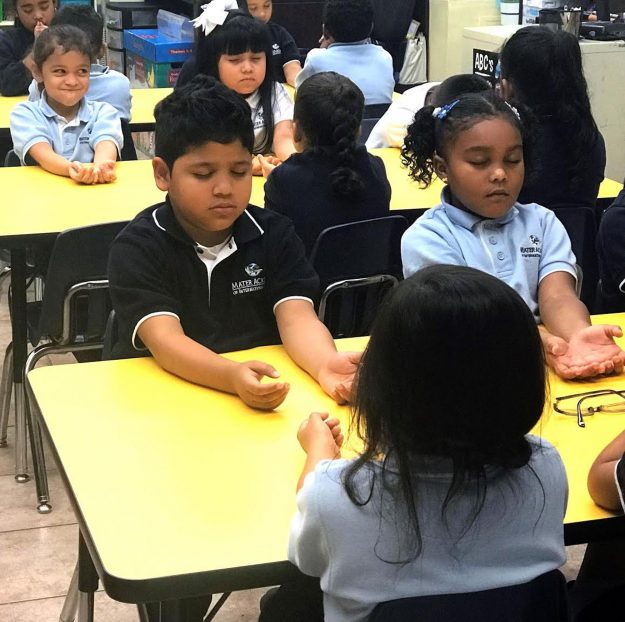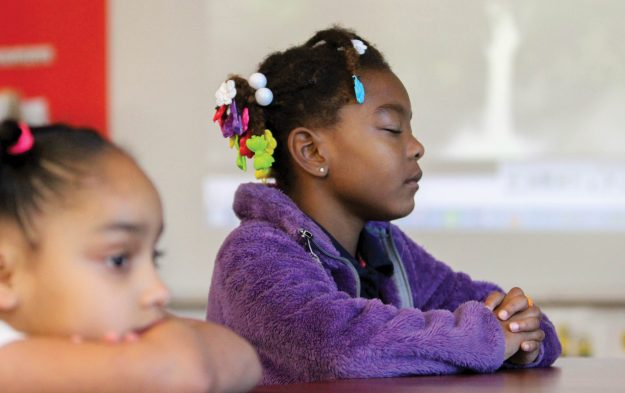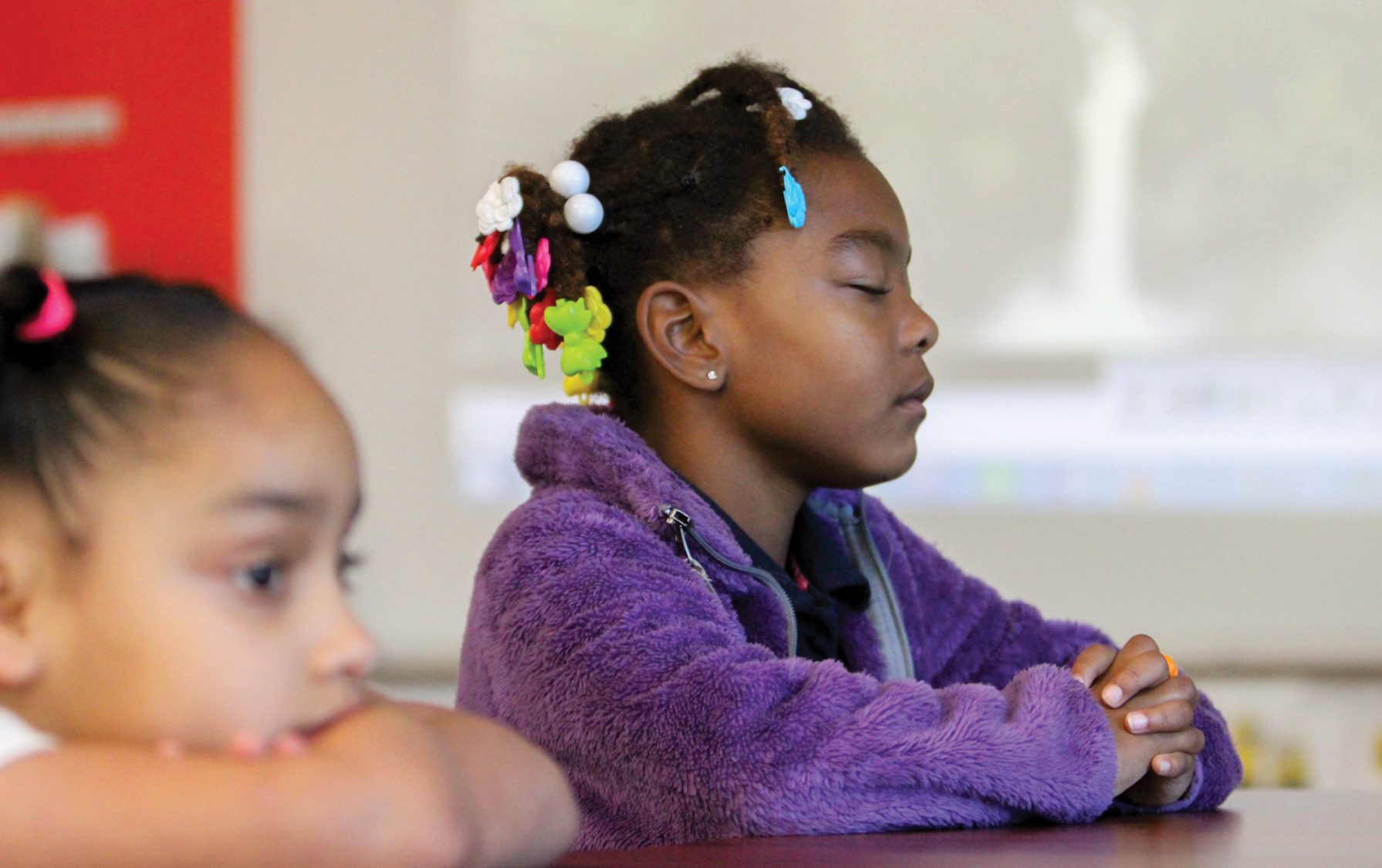In late 2018, a petition started by the American Center for Law and Justice (ACLJ) called “Stop Forcing Buddhist Meditation on Kids in School” began to circulate and ultimately gathered more than 85,000 signatures.
The ACLJ is a nonprofit religious organization that advocates for First Amendment protections, which it describes as “God-given rights.” The ACLJ was founded by minister and televangelist Pat Robertson in 1990; the organization’s chief counsel is Jay Sekulow, a personal lawyer to President Donald J. Trump.
Although Sekulow has stated on his radio show that mindfulness is a Buddhist practice that clearly violates the First Amendment, legal experts and mindfulness educators find it unlikely that current challenges to mindfulness in schools will reach the Supreme Court.
But with teachers, administrators, and school districts across the United States increasingly turning to mindfulness to reduce stress, boost productivity, and develop social and emotional skills in students and staff—and without a clear legal strategy in place to face future challenges—should advocates of mindfulness in schools be more concerned?
Much has been written, in Tricycle and elsewhere, about whether mindfulness can be truly secular and if it belongs in public schools. On the surface, this debate might be boiled down to us versus them, liberal versus conservative, the Bay Area versus the Bible Belt. Closer examination, however, can produce numerous conflicting—and confusing—layers of whether the practice can truly be separated from religious roots.
Mindfulness in schools certainly isn’t exclusive to the United States; in 2019, the United Kingdom’s education secretary said 370 schools would introduce mindfulness programs to address and study mental health in children. The US Constitution’s First Amendment provides a bit more wiggle room when it comes to religious expression, allowing for prayer before government meetings, clubs offering after-school Bible study, and downward dogs instead of jumping jacks.

Meditation in education is a booming business, and the Centers for Disease Control and Prevention reported that there was a significant increase in the number of children using meditation over the last five years, with 5.4 percent practicing in 2017 versus 0.6 percent in 2012. And while yoga and mindfulness have exploded in popularity in recent years, the first significant legal ruling was handed down back in the late 1970s, when a federal appeals court upheld a ruling that teaching an elective Transcendental Meditation course in five public schools in New Jersey violated the First Amendment. The court used what is known as the Lemon Test, a three-pronged approach to determine whether the First Amendment has been violated by asking whether the purpose or effect of the practice is religious and whether the government has become entangled in deciding a religious affair.
In more recent challenges, courts have found that practicing yoga in public schools is permissible not because yoga isn’t religious but because the school yoga practice has been stripped of religious references.
Candy Gunther Brown, a religious studies professor who has testified in several court cases about the religious roots of yoga and mindfulness and who authored Debating Yoga and Mindfulness in Public Schools, said that more recent opposition to mindfulness in schools, as seen in the ACLJ’s advocacy work, has to do with the worry that “children are being coerced, more subtly, to participate in a practice that conflicts with what their own religious convictions are.”
For author, longtime mindfulness educator, and former lawyer Susan Kaiser Greenland, it’s hard to tell what kind of bigger threat current challenges and future court cases pose, as each case depends on the strength of the challenge and the legal resources behind it.
“One of the reasons we don’t know is that the [mindfulness in education] community hasn’t done a good job of coordinating our response,” Greenland said. “The biggest threat to the movement as a whole is much broader than the court cases.”
Greenland said that many mindfulness programs are often “passion projects” that are created on a small scale and usually aren’t funded well enough to have the legal strategy or systems thinking that is needed, especially with well-funded individuals and organizations ready to challenge them. (Estimates in Sedlock v. Baird, a 2013 case that challenged the teaching of yoga in San Diego County, put the cost of pro bono legal services at more than $1 million for the yoga opponents.) Another reason is the proliferation of mindfulness itself—a necessary developmental stage of coordinating a response to legal challenges was skipped as different school training programs responded to the demand for curriculum.
Right now, there’s a flurry of concern when a new court case or challenge pops up, but as yet there is no clear leader or “coordinated, big picture effort” in the mindfulness-in-schools community.
“If we focus on these small cases, or worry just about the court challenges, it’s like playing Whac-A-Mole,” Greenland said, adding that educators in the field running programs on a day-to-day basis don’t have the bandwidth to focus on these overarching issues.
Congress shall make no law respecting an establishment of religion, or prohibiting the free exercise thereof, or abridging the freedom of speech, or of the press; or the right of the people peaceably to assemble, and to petition the Government for a redress of grievances.
— First Amendment to the United States Constitution
Moving forward, Greenland sees a clear need for what she calls a “neutral quarterback” to advocate for mindfulness in schools. This would be someone not connected with a particular program who could work to create unity within the community, as well as with those outside who are skeptical of (or apprehensive about) meditation, and who can coordinate a united approach to legal responses.
Greenland isn’t concerned about mindfulness itself violating the First Amendment because she believes that mindfulness has roots in other contemplative practices in addition to Buddhism. The problem, she said, is ensuring that mindfulness is presented in a way that is religiously neutral and in the best interest of children, which includes knowing how to handle trauma and making sure practices are age-appropriate.
“When you have a very enthusiastic individual going in to teach an after-school class on their own, armed with some books and their own personal practice, that person may not be aware that they are actually not keeping in mind the secular aspect,” Greenland said.
Such enthusiasm from improperly trained teachers can come in the form of Tibetan singing bowls, mandala coloring exercises, Buddha images, and Buddhist language, such as “sending lovingkindness”—indicators that may be viewed as neutral in more liberal circles but that elsewhere are clear indicators of religion.
This enthusiastic and accidental line-crossing is a problem that longtime educator and current instructional coach Shannon Pitcher-Boyea sees as well. Pitcher-Boyea, who started out as a classroom teacher and served as a principal in northern New York State before becoming certified to teach yoga and mindfulness, said that many parents and teachers have identified mindfulness as a potential answer to societal pressure, stress, bullying, and other systemic problems—and they don’t want to wait to try it out.
“The challenges that I see are that you have an eager staff member who always volunteers for everything, and then the administrator is so excited to have that eager staff member, so they let [the educator] take the reins, and they don’t necessarily have any training. The intent is to be helpful and save the day, but the impact can be quite different,” Pitcher-Boyea said.
This can translate to children being instructed to end yoga class with “Namaste,” which has happened when she has taught in schools.
“I was like, ‘Whoa, let’s put the brakes on; … let’s talk about that,” Pitcher-Boyea said, recalling her conversation with the teacher. “If you want this program to continue in your school, then please stop doing that, because it holds religious connotation, and that’s not why I’m here.”
Pitcher-Boyea described the rural communities she serves as “high poverty, high trauma,” and predominantly Christian.
“I don’t think that people are fighting [yoga and meditation] up here. I think that people see it as a tool that can help their kids. I think we all want that right now,” Pitcher-Boyea said.
And when she agrees to work with a school district, Pitcher-Boyea says she gives administrators a sample letter to tell parents what will happen ahead of time and give them the opportunity to opt out. (Brown, the author of Debating Yoga and Mindfulness in Public Schools, maintains that yoga and meditation cannot be separated from their religious roots simply by removing religious references. Her book, published in May 2019, advocates an opt-in model for yoga and meditation in public schools that allows students and their parents to choose to participate in mindfulness activities, as opposed to pulling children out of existing mindfulness classes.)
Pitcher-Boyea is a member of the International Mindfulness Teachers Association (IMTA), a nonprofit started in late 2017 to accredit individuals and programs teaching secular mindfulness, and said she’d like to see a similar body governing to make sure teachers and districts are being properly trained.
“I want people to see an urgency, that if we’re going to do this and get it right, then we have to invest in training with people that have credentials,” she said.
IMTA doesn’t have specific resources for teachers when it comes to First Amendment questions, but instead “refer[s] teachers to the founders of the program because they are the experts on their particular program,” said Dawa Tarchin Phillips, a Buddhist teacher and IMTA’s executive director.

“I think good modern mindfulness teacher training programs would do right by their candidates to include some training on civil liberties,” said Phillips, who added that he believes it is important to understand that contemplative practices, such as mindfulness meditation, predate organized religion.
Laura Bakosh is a longtime Mindfulness-based Stress Reduction (MBSR) practitioner and cofounder of Inner Explorer, a pre-recorded audio mindfulness program that is used in three thousand schools. She’s also intimately aware of the ACLJ’s challenges to Inner Explorer’s programs in Ohio and, most recently, in Colorado.
“There really hasn’t been an uptick in [parent] complaints,” Bakosh said, just more noise and awareness since the ACLJ petition and their involvement with a Colorado school board in the fall of 2018.
“We worked really [closely] with the school and the representative from the ACLJ through the administrator of the school to answer their concerns, and in a couple of cases changed the language on one of our scripts. They didn’t like the idea of telling kids they were connected to a broader universe—so we took it out,” Bakosh said. “We believe what we’re teaching children is a human capacity to attend; there’s nothing religious in our efforts, but languaging sometimes triggers people. There are lots of ways to say things, and when people have expressed concern, we’ve opted to find a different way to say this with the same level of understanding.”
Bakosh said that the ACLJ hadn’t been successful in stopping the Colorado program, or any other of their programs across the country; rather, these challenges have helped strengthen the organization’s mission to be flexible in language and provide information to parents about why Inner Explorer is secular. (The Colorado school, Bakosh said, has since renewed their contract with Inner Explorer.) She added that she doesn’t currently invest a significant amount of time fielding complaints or strategizing for the future.
Bakosh also says there’s a big disconnect between the mindfulness narrative and understanding. She notes that professors at Regent University (also established by ACLJ founder Pat Robertson), have been studying mindfulness, and the same is true at Christian colleges across the US.
“A lot of mental health professionals are turning to mindfulness because it’s solving these major issues of stress, anxiety, suicidal ideation,” Bakosh said. “There’s 40-plus years of scientific evidence; why wouldn’t you want to at least offer this to the patients you serve? This is effective and inexpensive, and there’s not a lot of downside.”
Finally, she sees a possible silver lining in all the attention being paid by organizations like the ACLJ. “If kids aren’t getting these skills [taught by mindfulness], we’re failing them,” Bakosh said. “Maybe this ACLJ thing is a blessing, is a positive, because it’s building awareness among educators that these tools are available that they might not know about otherwise.”
Thank you for subscribing to Tricycle! As a nonprofit, we depend on readers like you to keep Buddhist teachings and practices widely available.
